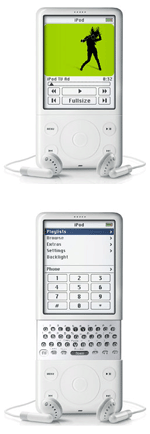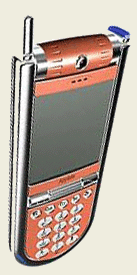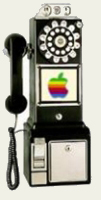Mobile Phones a Plum Market for Apple—If It Changes the Rules
 As mobile phones and smartphones become increasingly commonplace in mature and emerging markets, pundits increasingly predict that Apple will apply its design and experience expertise to field a mobile phone. Renowned for the elegance and simplicity of its devices and services, Apple provides unparalleled experience through world-class design of hardware, software and services. It delights and inspires customers by making the complex simple and beautiful.
As mobile phones and smartphones become increasingly commonplace in mature and emerging markets, pundits increasingly predict that Apple will apply its design and experience expertise to field a mobile phone. Renowned for the elegance and simplicity of its devices and services, Apple provides unparalleled experience through world-class design of hardware, software and services. It delights and inspires customers by making the complex simple and beautiful.
The market for computing devices, wireless access and information (content) is at the point of convergence, and its value chain players—access providers, device makers and information providers—are vying to grow their influence. The digital device is rapidly becoming the hub for an unlimited number of information services. For many people, it is the main access device to the Internet, more than a computer. Within the market for devices, smartphones represent the convergence of PDAs and phones.
But the market for “music phones” is crippled by intractable value chain conflict. Can Apple use its core competency to create sustainable competitive advantage by changing the rules?
Are Rumors Grounded in a Solid Business Case?
The never-ending rumor of an Apple mobile phone is reaching another crescendo this holiday season, when device fetish spikes for the year as people think about gifts they would like to give or receive. For example, on December 22, The Wall Street Journal predicted that an Apple phone would be unveiled at MacWorld next month (Waiting on Apple Cellphone Call, subscription required). As usual, Apple has been coy, neither confirming nor denying rumors, which only increases curiosity. Meanwhile, Wired featured an intriguing article on how the iPod came together (The Perfect Thing) that offered several insights about how Apple innovates. Since this rumor has gone on for years, I’ll also feature some customer “art” that’s traipsed the Web near and far, from newest to oldest.
Why Apple Might Want an “iPod Phone”
- Conventional wisdom has it that handset capabilities are exploding, and design is improving, so the iPod’s competitive advantage is dwindling. Also, the U.S., where iTunes debuted, is notorious for being computer-centric relative to the rest of the world. As Motorola’s Jim O’Connor pointed out in Technology Outlook for 2007, most Internet access in the world is now provided through mobile phones, not computers, and this trend is increasing. The number of handsets dwarfs all other devices: 75 million mp3 players will be sold in 2007—and 750 million mobile phones.
- In the Valley (where Apple is located), the mantra has always been to aim for a small slice of a huge market rather than a larger piece of a smaller market. But this is, er, conventional, and Apple inspires us because it surprises us and bucks trends.
- The iPod business increasingly drives Apple’s stock price, providing 40% of all revenue in its most recent quarter. This is a big market to lose, and it’s getting bigger fast.
- Apple’s business strategy is reflected by its iLife suite: creating experience through digital entertainment. Phones and cameras are arguably part of that experience.
 Looking into the Past to See the Future: Key iPod Success Factors
Looking into the Past to See the Future: Key iPod Success Factors
Apple innovated in several areas to create breakaway value with the iPod:
- Hardware: Apple broke new ground by using Toshiba’s (then) new 1.8 inch hard drive, which enabled the first iPod to hold 1,000 songs, a significant jump in quantity per device size at the time. It has continued to lead the category in size/design/performance.
- Software/Experience: perhaps even more important, the scroll wheel and interface enabled people to navigate their music in a highly intuitive way. With thousands of songs, it has to be practical and fun to navigate. The experience itself must add to, or at least not detract from, the entertainment experience. Apple positions its customers’ experience mostly in the fun area: “PCs are for work” even though “you can do that on a Mac, too.”
- Design: the device itself looked smashingly gorgeous, and it became an overnight fashion statement for virtually every demographic.
- Timing: Apple was late to the digital music device market but that didn’t matter because it changed the category through innovation; devices had been on the market for several years, but they were of little interest because they held too few songs and had poor battery life and interfaces. Apple’s core competencies enabled it to overcome these shortcomings.
- Business model: carrying thousands of songs in your pocket changed the model for how people experienced music: it is empowering customers to find, share and create music and video. Radio no longer is needed to discover music, nor are record companies to distribute it.
- Supply: the iTunes Music Store enabled users to buy a large variety of music legally; moreover, it provided a seamless user experience and instant gratification. Jobs’ role at Pixar bought him cred with music executives, which gave iTunes an important early lead. Today, the company is leading with introducing television and movies for video iPods.
- Standards: iPods play the industry standard mp3, but songs purchased at the iTunes Store are encoded in Apple’s proprietary format that will not play on other music players directly; they feature a DRM (digital rights management) system to protect music.
- Legal: Apple put itself in the middle of the struggle between music sharing consumers and angry/fearful music executives, and it took the high road by winning low prices and reasonable sharing ability along with DRM to limit piracy.
The Problems with Music Phones
There are two sets of problems with the concept of a music phone: business model and technical. Addressing the former, Wired’s Battle for the Soul of the MP3 Phone explains some of the difficulties posed by music phones and how the Motorola/Apple Rokr perished on the rocks. The intractable problem is that the three key players of the music phone value chain are not aligned around it. The value propositions of handset makers, music labels and wireless carriers are at odds, and the Rokr’s failure shows why. Wireless carriers did not want to carry it because the Rokr uses the iTunes Store and the computer to acquire music (Apple’s insistence), thus removing the value proposition to the carrier. Carriers make very little on providing talk time. In summary:
- Handset makers want to sell their devices, which can rival the iPod in terms of computing power. They are less concerned about music itself. However, they are beholden to carriers to subsidize and sell their phones.
- Wireless carriers make money by the network traffic generated when people buy songs through their phones, as well as by handling the billing. They serve as gatekeepers to the devices and try to force people to use their network. (ever try to exchange data between your phone and your computer or between phones? It’s an incredible hassle by design). Handset makers constantly complain that the carriers make them lobotomize their phones (Verizon forced removal of Bluetooth).
- Music labels want to increase demand for music without cannibalizing existing music sales. If an average CD has 10 songs and sells for $15, that implies $1.50 per song, and they don’t want to go much lower.
Placating all these players (and adding up their mark-ups) means that downloading music to wireless phones is far more expensive. Thus far, buying music through a phone, say, in the U.K., is more that twice as expensive as buying it through the iTunes Store. On the other hand, wireless customers worldwide spend billions on ringtones, often between $2 and $3 U.S. per ringtone. The logic goes that spending a like amount on music won’t be a stretch for consumers. In a bit of irony, buying a 30 second ringtone is often triple of the price of the whole song!
From the technical point of view, playing music and making/receiving phone calls are completely different. Music players have the circuitry and headsets to play high quality sound, while phones offer voice quality (much lower). Music players have large hard drives and batteries while phones have small flash drives for storing data, and their batteries are designed for spiky use (i.e. standby vs. talk), where music players are designed to use a consistent level of energy over a long period of time. Moreover, a dead iPod battery is unfortunate and inconvenient, but a dead mobile phone can be far more serious. For more on this, see Roughly Drafted’s excellent article, Why Mobile Phones Make Bad iPods. In addition, each component of an electronic device uses power differently (i.e. screens, hard drives, processors, antennas), and the more components that draw from the same battery make that power management less efficient. For more, see Wired’s Building a Better Battery.
 Smartphones: Music Phones?
Smartphones: Music Phones?
Smartphones (Treo, Blackberry), which are truly handheld computers that usually combine a PDA and a mobile phone, offer a quantum leap in capability (and complexity). However, they are fundamentally based on a different proposition than music phones. They are work-based devices that feature text-based communication and keyboards. The primary interface is text-based and menu-driven. Most of them play music and have photo books. However, they are expensive and complex, and most users use very few of their functions. Moore’s Law can rectify the price but not the complexity problem. They do many things but none of them very well, and they offer little to no improvement over the energy problems of mobile phones (above).
Notably, they are being pushed because they align carriers’ and handset makers’ goals: they offer a large feature set and relatively high unit cost for makers, and they enable carriers to push their advanced network features, driving extra revenue. The only problem is, consumers often don’t buy the extra services, and adoption is proceeding slowly.
That said, smartphones do have an important bearing on the market for music because they do away with mobile phones’ proprietary operating systems, and they have far greater file sharing capabilities. Nokia’s head of multimedia, Anssi Vanjoki, predicts that P2P (peer to peer) file sharing will threaten the labels’ hegemony over music and delight carriers because file sharing will drive bandwidth usage. However, exchanging songs via Bluetooth would take the carrier and the label out of the loop. That said, I can see no reason why labels would not fight file sharing on phones the same way they did for computers, and file sharing over a network would be more trackable (and therefore easier to prosecute) than Bluetooth. Plenty of it would go on, but officially it will be illegal, and labels would protect their turf. This could present an opportunity for Apple, as it has a track record for offering a legal, fair solution.
How Apple Could Change the Rules for the Music Phone
Based on the technical and business problems posed by music phones, I doubt that Apple will field a device that combines a phone and an iPod. The devices are not compatible, and it’s not even clear that such a device would sell well. The complexity of such a device would be inescapable, its cost would be high, and (wireless) service providers wouldn’t want to subsidize it because it would enable customers to circumvent their networks for data sharing (as happened with the Rokr). That said, the market for phones is huge, and it is ripe for significant change in the near future, so I think Apple will address it, but it will do so in an unexpected way.
First, a couple of caveats:
- Apple will maintain its design strategy for encapsulating complexity. It popularized the entertainment device category based on the idea that they are “pods”—or extensions—of computers: they gain simplicity because much of the management of content is done at the computer, which enables more simplicity in the device itself. Notably, none of these devices require textual input; they are all menu driven.
- Apple will probably extend this concept to any phone design, treating the iPod as the player component and the phone as a separate wireless component.
- To address the growing part of the market that does not have computers to manage the content on their devices, Apple could offer hosted iPhoto, iTunes, Address Book and iCal capability through .Mac (website, managed via the phone itself or via Internet cafe).
 The Most Probable first offering: A Mobile Phone That Is NOT a Music Phone
The Most Probable first offering: A Mobile Phone That Is NOT a Music Phone
This phone would feature Apple’s drop-dead design looks, and it could be designed to be complementary to iPods and be priced so that customers would pay full price, as they do for iPods. The phone would provide iLife-enriching Web browsing and a video and still camera. Moreover, it could be sold as an unlocked GSM phone that customers would buy on their own, so it would not have to depend on carriers’ good graces to sell. Unlike other device makers, Apple has well developed retail and service capabilities. Having a really cool phone that was comparable in cost to a Nano or an iPod would be within reach of many people. For people who really wanted one device, some models could even offer a docking feature that would snap the two together in some way.
Taking the idea further, if Apple Bluetooth-enabled iPods, the phone and iPod could share information seamlessly. The company already pushes this concept with iSync, but the problem is that the phones aren’t terribly compatible with it, a bête noire for power users. For example, the phone could leverage the iPod’s large memory capacity. In effect, they could operate as one device, bonded by Bluetooth.
Having such a phone would significantly extend Apple’s brand experience to many more people; it would expand the iLife footprint. It would be profitable for Apple and play to the company’s core competencies. It wouldn’t be very risky. As to whether Apple would become an MVNO (Mobile virtual network operator) like Virgin Mobile, I would bet against that, right away at least. It’s a brutal, low-margin business outside of Apple’s core competency.
The Runner up: A VoIP Phone
 More interesting still would be if Apple were to partner with Skype to field a VoIP (Voice over Internet Protocol or Internet calling) phone. This would offer free calls to other users anywhere in the world and no wireless contract, and it would become increasingly viable as hotspots grow and cities become metropolitan-wide hotspots. Skype offered North America users free “SkypeOut” calls (Skype users call any normal phone number) for most of 2006 in a bid to drive member subscriptions, and Apple could be a very effective partner to drive Skype memberships (which are free). Skype already offers “normal” phone numbers (“SkypeIn”) so that any phone can call a Skype member as well as voice mail, chat, video chat, conferencing, etc.
More interesting still would be if Apple were to partner with Skype to field a VoIP (Voice over Internet Protocol or Internet calling) phone. This would offer free calls to other users anywhere in the world and no wireless contract, and it would become increasingly viable as hotspots grow and cities become metropolitan-wide hotspots. Skype offered North America users free “SkypeOut” calls (Skype users call any normal phone number) for most of 2006 in a bid to drive member subscriptions, and Apple could be a very effective partner to drive Skype memberships (which are free). Skype already offers “normal” phone numbers (“SkypeIn”) so that any phone can call a Skype member as well as voice mail, chat, video chat, conferencing, etc.
Of course, the hitch with a VoIP-only phone is that it wouldn’t be usable everywhere. Moreover, logging into hotspots isn’t for the faint of heart sometimes, and the phone wouldn’t have a robust ability to deal with complications since it wouldn’t have a keyboard.
In this case, the phone would not even be a mobile phone in the traditional sense since it wouldn’t use any existing cellular network. Apple would partner with a WiFi provider to provide a consistent level of service. There could be any number of tie-ins with other services such as iChat, Apple’s Skype-like instant messaging service.
Having a VoIP phone would position Apple as a leader in digitally native communication, where telephony is going anyway. If calling were free, that would be a significant value proposition for global calling, and it would align with Apple’s penchant for game-changing. It would also partner Apple with avant guard Skype, which could drive significant synergies and extend Apple’s footprint globally.
Redefining Mobile Communications
From a near-term perspective, the non-music mobile phone would be a double that would enable Apple to get into the game profitably. It makes logical sense; however, I don’t think Apple would do it unless they could offer some experience-defining feature beyond having the best-looking phone out there. Apple is accustomed to controlling hardware and software, and the wireless service providers influence a huge part of the software. The mobile phone market is so mature, and Apple is a high-profile player.
The VoIP phone would offer Apple that largest chance to redefine the mobile communication experience because all the services and growth will be in digital communications technology, and innovation will offer the largest upside potential. A far greater number of services is possible, including wireless access to the iTunes Store (again, working in conjunction with the separate iPod). That would be value-defining: providing wireless downloads of content from iTunes for 99 cents (possible because there is no wireless service provider conflict, and the iTunes Store is already there; all you have to do is access it). Competitors could not match that any time soon.
They would even offer worldwide entertainment events (imagine, U2 concerts), incorporating certain elements of satellite radio but also featuring consumer-created content. They could allow bands and people a mobile distribution network to release new music/videos. Mobile YouTube. The list is endless.

Leave a Reply
You must be logged in to post a comment.